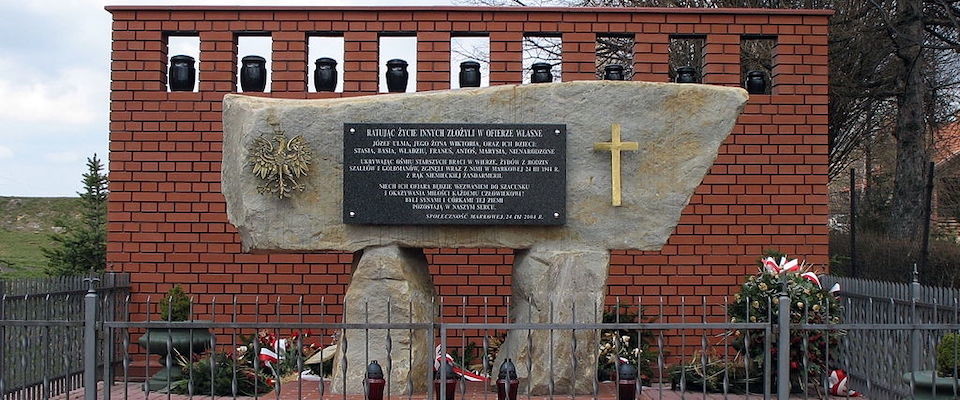THE BLESSED ULMA FAMILY AND OUR CATHOLIC MOMENT
It’s a rare occasion when the word “unprecedented” can be used for a Church whose history extends over two millennia. Yet something unprecedented happened in the Polish village of Markowa on September 10, when an entire family, including their unborn child, was beatified. It seems not quite right to refer to the new blesseds by the traditional formula, “Blessed Józef and Wiktoria Ulma and Companions,” the “companions” in question being the Ulmas’ six living children and their unborn child. Let’s instead think about the Blessed Ulma Family and what they might mean for us.
Beginning in late 1942, Józef and Wiktoria Ulma sheltered eight Jews in the attic of their wooden farmhouse: a capital crime during the German Occupation of Poland in World War II. On March 24, 1944, German gendarmes came to the house, murdered the Jews, and then shot Józef and Wiktoria, who was late in her pregnancy. The terrified children—Stanisława (8), Barbara (6), Władysław (5), Franciszek (4), Antoni (3), and Maria (1½)—were then gunned down. The bodies were dumped in a pit and later reburied in the local church cemetery.
When I visited the nearby Museum of Poles Saving Jews in World War II this past July 23 and prayed at the Ulma family tomb near their parish church of St. Dorothy, lessons for twenty-first-century Catholicism came to mind.
The first involves the sources of Christian heroism. While both Józef and Wiktoria Ulma were well-educated by the mid-twentieth-century standards of rural Poland, they were not theological sophisticates. They read the parable of the Good Samaritan (Luke 10:25–37) not as a general injunction to love of neighbor that could be adapted to circumstances but as a specific instruction from Christ the Lord—if you encounter people in distress, you must help them, irrespective of their ethnic or religious identity and regardless of the cost.
Some contemporary Catholic leaders find such a literal reading of the Lord’s words uncomfortable; they suggest that the moral code that follows from such biblical “fundamentalism” is “rigid,” “ideological,” and insufficiently pastoral. Yet the same “rigid” sense of biblically-grounded moral obligation that animated the Ulmas’ heroic sheltering of persecuted Jews led Fr. Maximilian Kolbe to offer his life in the starvation bunker at Auschwitz in exchange for that of a condemned prisoner, just as it led Mother Teresa to spend out her life in service to the poorest of the poor, whom she regarded as “Jesus in his most distressing disguise”; just as it led U.S. Navy chaplain Fr. Vincent Capodanno to sacrifice his life bringing comfort to wounded and dying Marines in Vietnam. Neither the Ulmas, Fr. Kolbe, Mother Teresa, nor Fr. Capodanno indulged in the “proportionalist” weighing of moral obligations that has returned to favor during the present pontificate. They lived the parable of the Good Samaritan literally—those who find that “rigid” and “ideological” should think again.
The second lesson involves the nature of martyrdom, which the death of St. Maximilian Kolbe and the drama of the Blessed Ulma Family invite the twenty-first-century Church to reconsider.
Traditionally, a “martyr” was someone killed in odium fidei (in hatred of the faith). Did Kolbe’s self-sacrifice satisfy this definition, such that he was a “martyr” as well as a confessor of the faith? Were the Ulmas’ murderers motivated by odium fidei? The hybrid category “martyr of charity” has come into vogue in recent decades since Pope Paul VI used it of Kolbe. But it seems that Kolbe’s sacrifice, and that of the Ulmas, satisfies while developing the traditional definition.
Certain modern political theories teach a radical contempt for the dignity and value of human life, or at least the dignity and value of some human lives. That was certainly the case with German National Socialism: to the Nazis, Jews and the Poles who sheltered them were lower life forms to be exterminated. Is that not hatred of the biblically informed faith that, in Genesis 1:26, teaches that every human being is created, like Adam and Eve, in the divine image and likeness? Is not hatred of those made in God’s image and likeness hatred of God? And is not odium Dei a form of odium fidei?
The Synod that opens next month bids us to be a Church of “communion, participation, and mission.” The Blessed Ulma Family lived in communion with the persecuted Jews of Subcarpathian Poland and participated in the Mystery of the Cross by living the mission of the Good Samaritan, to which they were called in baptism. May their example inspire Synod 2023 to a similarly radical embrace of the Catholic faith.
George Weigel’s column “The Catholic Difference” is syndicated by the Denver Catholic, the official publication of the Archdiocese of Denver.

George Weigel is Distinguished Senior Fellow of Washington, D.C.’s Ethics and Public Policy Center, where he holds the William E. Simon Chair in Catholic Studies.
First Things depends on its subscribers and supporters. Join the conversation and make a contribution today.

No comments:
Post a Comment